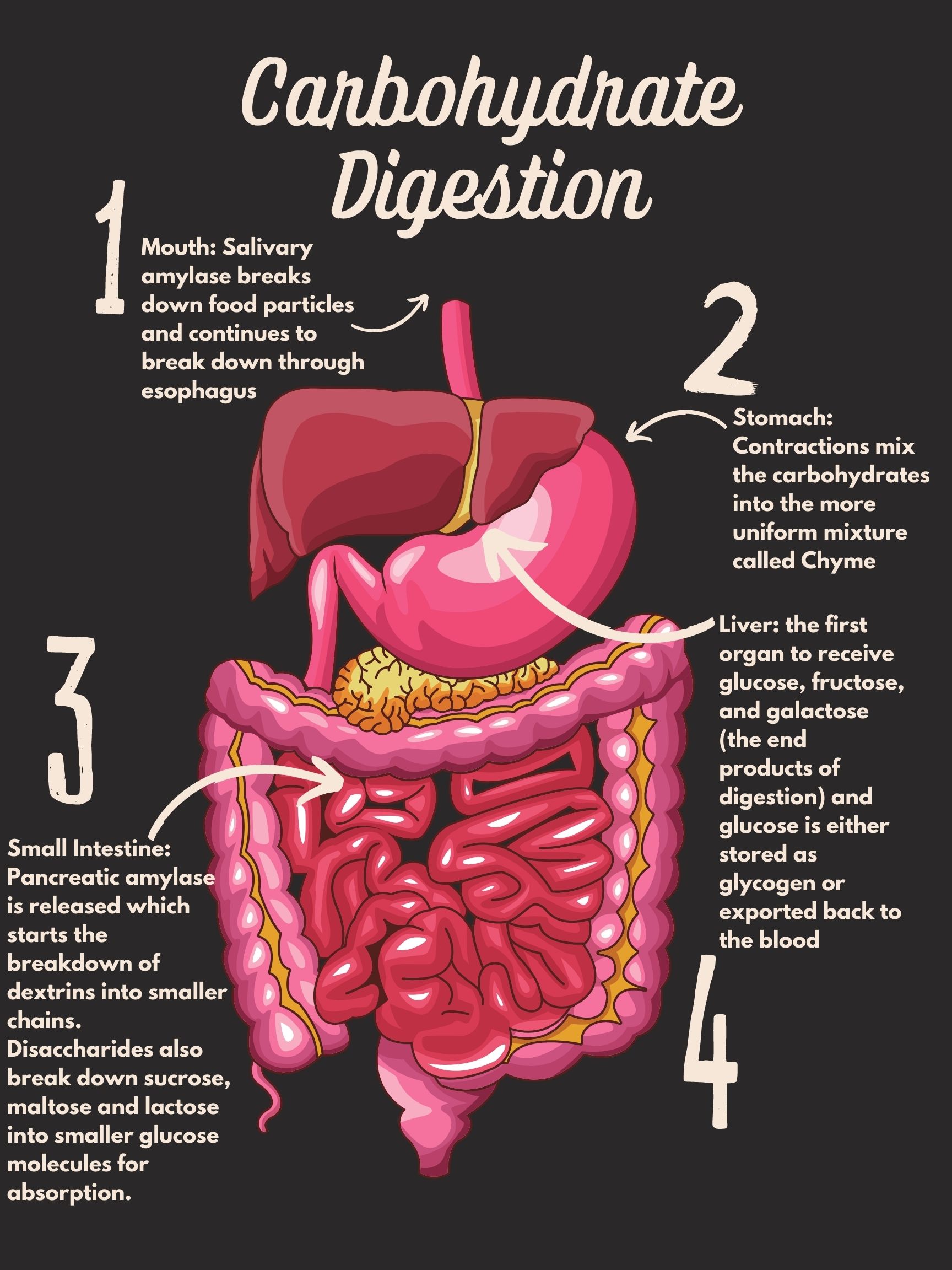5.5 Carbohydrate Digestion and Absorption
Figure 5.12 Overview of Carbohydrate Digestion

The mechanical and chemical digestion of carbohydrates begins in the mouth. Chewing, breaks the carbohydrate foods into smaller and smaller pieces. The salivary glands secrete saliva that coats the food particles. Saliva contains the enzyme, salivary amylase. This enzyme begins to break the bonds in starches. The salivary amylase breaks down amylose and amylopectin into smaller chains of glucose, called dextrins and maltose. The increased concentration of maltose in the mouth that results from the mechanical and chemical breakdown of starches in whole grains is what enhances their sweetness. Only about five percent of starches are broken down in the mouth. (This is a good thing as more glucose in the mouth would lead to more tooth decay.) When carbohydrates reach the stomach no further chemical breakdown occurs because the amylase enzyme does not function in the acidic conditions of the stomach. But mechanical breakdown is ongoing—the strong muscular contractions of the stomach mix the carbohydrates into the more uniform mixture of chyme.
The chyme is gradually expelled into the upper part of the small intestine. Upon entry of the chyme into the small intestine, the pancreas releases pancreatic juice through a duct. This pancreatic juice contains the enzyme, pancreatic amylase, which starts again the breakdown of dextrins into shorter and shorter carbohydrate chains. Additionally, enzymes are secreted by the pancreas and intestinal cells that line the villi. These enzymes, known collectively as disaccharidases, are sucrase, maltase, and lactase. Sucrase breaks sucrose into glucose and fructose molecules. Maltase breaks the bond between the two glucose units of maltose, and lactase breaks the bond between galactose and glucose. Once carbohydrates are chemically broken down into single sugar units, or monosaccharides, they are then absorbed into the intestinal cells.
When people do not have enough of the enzyme lactase, lactose is not sufficiently broken down resulting in a condition called lactose intolerance. The undigested lactose moves to the large intestine where bacteria are able to digest it. The bacterial digestion of lactose produces gasses leading to symptoms of diarrhea, bloating, and abdominal cramps. Most people with lactose intolerance can tolerate some amount of dairy products in their diet. The severity of the symptoms depends on how much lactose is consumed and the degree of lactase deficiency.
Monosaccharides are transported from the intestinal cells to the liver via the hepatic portal vein. The first organ to receive glucose, fructose, and galactose is the liver. The liver takes them up and converts fructose and galactose to glucose. Glucose is either stored in the liver as glycogen or exported back to the blood. How much glucose the liver exports to the blood is under hormonal control and will be discussed in the next section.
Almost all of the carbohydrates, except for dietary fiber and resistant starches, are efficiently digested and absorbed into the body. Some of the remaining indigestible carbohydrates are broken down by enzymes released by bacteria in the large intestine. The products of bacterial digestion of these slow-releasing carbohydrates are short-chain fatty acids and some gasses. The short-chain fatty acids are either used by the bacteria to make energy and grow, are eliminated in the feces, or are absorbed into cells of the colon, with a small amount being transported to the liver. Colonic cells use the short-chain fatty acids to support some of their functions. The liver can also metabolize the short-chain fatty acids into cellular energy. The yield of energy from dietary fiber is about 2 kcals per gram for humans, but is highly dependent upon the fiber type, with soluble fibers and resistant starches yielding more energy than insoluble fibers.
Media Attributions
- Carbohydrate Digestion © Natalie Fox is licensed under a CC BY (Attribution) license
